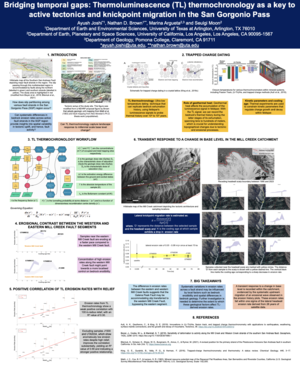2025 CSDMS meeting-028
From CSDMS
(if you haven't already)
Log in (or create account for non-CSDMS members)
Forgot username? Search or email:CSDMSweb@colorado.edu
Browse abstracts
Bridging Temporal Gaps: TL Thermochronology as a Key to Active Tectonics and Knickpoint Migration in the San Gorgonio Pass
Ayush Joshi,
(He/Him),University of Texas Arlington Arlington Texas, United States. ayush.joshi@uta.edu
Nathan Brown, University of Texas Arlington Arlington Texas, United States.
Seulgi Moon, University of California Los Angeles Los Angeles California, United States.
Marina Argueta, University of California Los Angeles Los Angeles California, United States.
The San Gorgonio Pass (SGP) within the southern San Andreas Fault zone is a structurally complex region that plays a crucial role in controlling earthquake rupture propagation, making it a key area for seismic hazard assessment. However, significant knowledge gaps persist regarding fault activity over the past 1–100 ka, particularly along the Mill Creek Fault segment in the San Bernardino Mountains. Traditional methods for estimating slip rates are hindered by the scarcity of datable materials and the challenging terrain of the SGP, necessitating innovative approaches to quantify uplift rates along overlooked fault segments. In this study, we employ thermoluminescence (TL) thermochronology to assess differential uplift by quantifying bedrock erosion rates. While Apatite (U-Th)/He (AHe) dating provides insights into long-term exhumation histories over millions of years and cosmogenic ¹⁰Be dating captures surface erosion rates on millennial timescales, neither fully resolves Quaternary uplift patterns essential for understanding active fault dynamics. TL thermochronology, sensitive to exhumation over 10–100 ka, bridges this crucial temporal gap, offering a novel means to decipher recent fault activity. By comparing erosion rates across multiple faults in the SGP, our results confirm that the Mill Creek Fault remains active and, importantly, reveal the geomorphic response to tectonic forcing within the San Bernardino catchment. We detect knickpoint migration, a hallmark of fluvial adjustment to uplift, and leverage TL thermochronology to estimate its lateral migration velocity. This study serves as a proof of concept, demonstrating TL thermochronology’s unique ability to not only quantify differential uplift but also track the interplay between tectonic uplift and fluvial incision. Our findings highlight the immense potential of this method for investigating active tectonics in other similarly complex fault systems worldwide.

